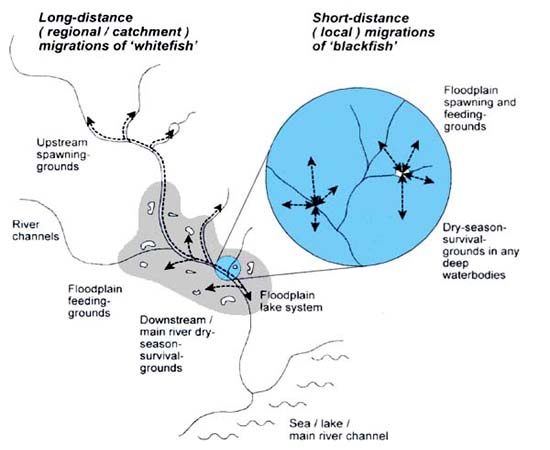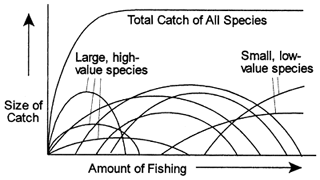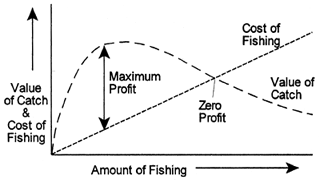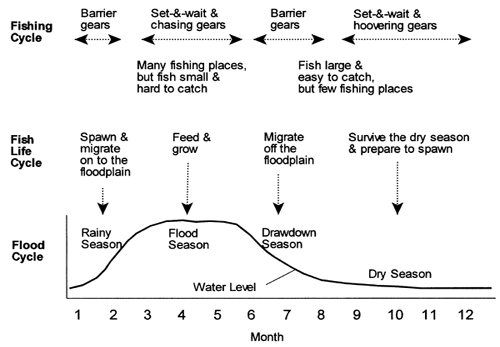All fisheries depend on an interaction between the environment, the fish which depend on that environment, and the fishers who catch the fish. As illustrated below, the complexity of each of these factors is at a maximum for floodplain fisheries resources:
| Resource Component | Simple fishery (e.g. lake or marine trawl fishery) | Floodplain River Fishery |
| Environment | Stable over time | Seasonal fluctuations within year Variable flooding between years |
| Single habitat | Many habitats Habitats vary between localities | |
| Resource mainly used for fishing | Strong competition for resource use | |
| Fish | Single / few species | Multiple species Variable behaviours and requirements |
| Fishing | Single gear type | Numerous gear types |
| Commercial / capital intensive | Artisanal / labour intensive | |
| Similar fishing communities | Different fishing communities | |
| Few central landing centres | Many dispersed landing centres |
This complexity may partly explain why relatively little attention has been given to floodplain river capture fisheries, compared to marine fisheries. A further factor may be the importance of local conditions on the effectiveness of different rules (including government regulations and traditional rules). This dependence prevents the use of a single, standard management approach for all floodplain resources. Though floodplain fisheries are, complex, this complexity is manageable, given the right management approach, and a clear sharing of responsibilities.
The rest of this section describes the particular characteristics of floodplain fisheries, in three categories: environment, fish and fishing. Sections 3 and 4 further develop the implications of these characteristics on who may best manage floodplain fisheries, and how.
Multi-species, multi-gear floodplain fisheries have more complex interactions between the environment, the fish and the fishers, than any other type of fishery
Though floodplain fisheries are complex, this complexity can be made more manageable by the right management approach and a clear sharing of responsibilities
Floodplain systems comprise many different habitats and may provide many alternative livelihoods
Floodplains are the most highly productive part of any river system. Their productivity derives from both the inputs of nutrients from upstream and the seasonal recycling of plants and animals which occurs with each ‘flood pulse’. Though the main river channels supply the floodplain with nutrients, they are relatively unproductive themselves, due to their strong currents and shifting substrates. They may also bring down any negative impacts of poor management from upstream: both the quality and the quantity of water in rivers is vital for maintaining productivity. Reductions in water flows may be caused by diversion of water into upstream irrigation schemes. Dangerously high flooding and dry season water shortages may both be caused by deforestation, when water runs more quickly off logged hillsides. In large rivers, such impacts may flow across international borders.
River catchments, and the highly productive floodplain systems in particular, may thus provide many alternative livelihood opportunities. With careful planning, such activities may be compatible. There may also, however, be negative interactions, particularly where sectors are unaware of each others needs. With multiple resource use, it may often be difficult to determine which sector is actually causing a given impact.
River habitats change gradually from the fast-flowing upland streams to the slow, meandering lowland rivers. Habitat diversity is highest in the floodplain sections, with flooded grasslands, flooded forests, small and large river channels, and permanent and temporary lakes and pools. Each of these habitats is used by different fish species for their essential life processes, such as spawning and feeding. Key habitats are normally accessible through floodplain channels: these may need to be maintained in highly exploited or modified river systems. The mixture of habitats varies significantly between localities and determines the types of management measures likely to be of use. Where maintained, the complexity of the resource may support extremely high fish biodiversity.
The floodplain environment also varies seasonally, both within the year, and between different years. The annual cycle divides the year into periods of high fish productivity during the flood season, and relative inactivity and hardship during the dry season. Variability in the size and duration of these seasons affects the productivity of the floodplain and the effectiveness and profitability of the fishery. Variability in the timing of the seasons prevents the use of rigidly-timed management frameworks.
Floodplains are increasingly being modified on both a large scale and a small scale
Floodplains are increasingly being modified on both a large scale and a small scale. Governments are building dams, impoundments and polders to generate electricity and control flooding. Local communities are reclaiming floodplain land for farming, and digging fish pits to catch fish. River channels are becoming blocked by siltation. Though sometimes beneficial to other sectors, such changes can have significant impacts on fisheries productivity. Though the impact of individual small-scale modifications may be minor, their cumulative effect may be large.
| Management implications of the floodplain river environment |
|
Migratory whitefish must be managed in much larger management units than local blackfish
Tropical floodplain river fish stocks may comprise over 200 different species of fish. Around 30 different fish species are commonly caught by floodplain fishers in any one locality. Each species clearly can not be managed individually, and it is usually necessary to group species into management units, or ‘guilds’. For this purpose, floodplain river fish may be categorised in one or more of the following ways:
From a management perspective, the first two categories (migration and feeding) are the most important. Fish migrate to find the best conditions for breeding, feeding and survival in different parts of the river system. Some ‘whitefish’ migrate thousands of kilometres up and down rivers, while other ‘blackfish’ may spend most of their lives in a single waterbody (see Figure 2.1). Blackfish species are able to tolerate the de-oxygenated conditions of the dry season in floodplain waterbodies while whitefish usually return to the main river or large lakes to survive. In Asian rivers, blackfish include species such as the snakeheads and the climbing perch (Anabas testudineus), while whitefish include many large carps and riverine catfish in addition to the valuable giant prawn (Macrobrachium rosenbergii). The alternative migration patterns of blackfish and whitefish determine whether they are vulnerable to many different fishing communities across the river catchment or to only one or a few local ones. To be effective, fisheries managers must regulate the activities of fishing communities across the full range of a species' distribution. Whitefish species must therefore be managed in much larger ‘management units’ than blackfish.
The combination of migration patterns and feeding behaviours determine which species are caught by which fishing gears, and at which times. Strongly migratory whitefish, for example are caught by barrier traps; predatory fish are caught by baited hooks; air-breathing blackfish are caught by fish drives in dry season floodplain pools. Multi-species floodplain fish stocks have many ‘interactions’ with the multi-gear fishery: every type of fishing gear always catches several types of fish, and every fish species is always caught by more than one fishing gear. Fish behaviours thus determine which species will be affected by management regulations on certain gears or certain seasons. The strong interactions between gears and fish mean that no single gear or fish species should be managed independently of the overall fishery.
Floodplain fish production is dependent on the maintenance of high habitat diversity, seasonal flooding with clean water, and clear channels for fish migrations
Managers must choose between high employment with low profits or less fishing for a higher quality catch
Asian river fisheries are highly productive, with average catches of around 100kg per hectare of floodplain. Surprisingly, this overall catch rate is not strongly affected by the amount of fishing. Though heavy fishing may over-exploit certain species, these may be replaced by other members of the multi-species stock (see top two graphs in Figure 2.2). As long as stocks are not completely wiped out (e.g. by fishing with poison), multi-species floodplain river fisheries can thus maintain high catch rates even with extraordinarily high levels of fishing effort.

Figure 2.1 Alternative migration patterns of riverine ‘whitefish’ and ‘blackfish’
Heavy fishing of floodplain fish stocks thus mainly affects the species of fish caught, not the total weight of the catch. Since fishers tend to exploit the most valuable fish species first, these are usually the first to decline. Though catches may remain high in a heavily exploited fishery, their value may eventually decline to the point where they are less than the costs invested in fishing for them (see bottom graph in Figure 2.2). Managers must thus choose whether to allow heavy fishing for very little profit (e.g. where the objective is to generate employment or provide nutrition to poor people), or to restrain the amount of fishing to improve the types of fish caught and the overall value of the catch.
As discussed in other sections, the activities of other resource-users in a river catchment may also affect the productivity of the fishery. The impacts of pollution, and losses of spawning habitats, for example, may be far more significant than those from fishing. Such impacts may be hard to detect or even investigate, but their existence calls for active participation in intersectoral talks on the use of the shared river resource.
| Management implications of floodplain fish stocks |
|
Fishing communities are usually distributed throughout the floodplain river system. The fishing opportunities of each community depend on the types and sizes of waterbodies to which they have access. In some localities, small floodplain waterbodies may be traditionally associated with villages, or ‘owned’ by them. Other waterbodies, particularly larger lakes, main river channels and open floodplains, may be less easy for a single community to control, and may be openly accessible to fishers from many surrounding communities. The spatial relationships between riverine waterbodies and the communities near to them thus determine who may be able to manage effectively. Where traditional management exists, this should be encouraged and built upon, to take advantage of existing skills.
Hoovering gears must be managed to ensure the dry season survival of blackfish
Floodplain rivers are fished by many different types of people. Fishers may be full-time professionals, often working as groups with expensive fishing gear, or only part-time, perhaps working on their own with more simple gear. Part-time fishers often alternate seasonally between fishing and other occupations, such as agricultural labouring. ‘Subsistence’ fishers are usually dependent on fishing to provide their daily meals. In poor, heavily-populated countries, where the costs of some types of fishing may be very low and alternative labour opportunities very limited, the numbers of fishers can rise to exceptionally high levels.
These different types of fishers rarely operate independently of each other. Floodplain fisheries often have complex arrangements (traditional or formal) for controlling access of fishers to different waterbodies. Poorer fishers are often unable to pay for expensive fishing fees up-front, and must rely on credit in some form. This may give rise to sub-licensing of individual gears or fishers within sub-divisions of waterbodies. The fishing community may then be a complex network of ‘stakeholders’, with leaseholders, middle-men and fishers at various levels of authority and dependency. Where they exist, such community networks may be valuable instruments for improving control of the fishery.
Barrier gears must be managed to ensure the access of whitefish to their spawning grounds
The spatial relationships between waterbodies and the communities near to them determine who will be able to manage effectively
Floodplain fishing communities often comprise a complex network of stakeholders, with leaseholders, middle-men and fishers at various levels of authority and dependency
The diverse habitats and fish species of floodplain rivers are reflected by an equally diverse range of fishing gears and operations. Each river may be fished by twenty or more gears, which may be categorised into one of the following four types (see Figure 2.3):
Set-and-wait gears are set and hauled after a few hours, and catch fish when they are feeding or moving around the floodplain (e.g. gill nets, portable traps and baited hooks).
Chasing gears involve more active pursuit of fish by fishers, sometimes even in open floodplain waters (e.g. drag nets, push nets, some types of seine nets and spears).
Barrier gears are set more permanently than set-and-wait gears to catch whitefish during their seasonal migrations. Barrier gears may be set both in the main river (where it is narrow enough), or in the secondary channels where fish migrate off the floodplain when waters fall. They may also be complete barriers (e.g. suspended trawl nets, bamboo barricades) or only partial barriers, which do not span the full width of the channel (e.g. lift nets, fyke nets etc.).
Hoovering gears are used in the dry season to catch blackfish stranded in pools and river channels (e.g. fish drives, electric fishing, and - most dangerously - poison and dewatering).
 | Single Species Fishery |
| Moderate fishing gives maximum catch | |
| Too much fishing causes extinction or depletion | |
 | Multi-Species Fishery |
| Total catch approximately constant | |
| Valuable species become extinct or depleted first | |
 | Economics of Multi-Species Fishery |
| Moderate fishing gives maximum profit | |
| Too much fishing may give zero profit |
Figure 2.2 Simple relationships between fishing, catches and profit for a multi-species river fishery
This wide variety of fishing gears enables the capture of the many different fish species in all the different floodplain habitats, and in the various seasons of the year. Set-and-wait gears and chasing gears may catch fish at any time, but are usually labour intensive and fairly inefficient. Barrier and hoovering gears, in contrast, are very much more efficient as they catch fish at those times when they are highly concentrated in specific habitats (barriers in channels, and hoovers in dry season waterbodies - see Figure 2.4). Access to such habitats will usually be in strong demand and thus require some management to prevent conflicts.
The relative numbers of each type of gear used in a fishery determines the distribution of catches between the members of the fishing community. Many of the fishing gears will compete for the same fish species, so that the excessive use of one gear, say in the flood season, will decrease the catches of a second gear used either at the same time or later in the dry season. Owners of large barrier and hoover gears may thus wish to prevent the excessive use of gill nets during the flood season to maximise their own catches during the drawdown. Where such large gears are expensive, their profitability may indeed only be assured by limiting the earlier fishing of other small gears. A fishery with many set-and-wait and/or chasing gears will have a wide distribution of fish catch among the community. In contrast, one with only barrier and hoover gears will usually have less operators and a narrower distribution of catches. Most fisheries involve a balanced mixture of both types of gear.
| Figure 2.3 Types of floodplain river fishing gears |  |
The high effectiveness of barrier and hoovering gears makes them particularly threatening for the long-term sustainability of fish stocks. Managers must ensure that barrier gears do not prevent the upstream spawning migrations of whitefish, and that hoovering gears do not catch all the blackfish during the dry season. The use of barriers during the rising water seasons, or of poisons, electric fishing or dewatering during the dry season are especially dangerous.
| Management implications of floodplain communities and fishing |
|
 | Figure 2.4 The relationships between the seasonal cycles of fishing, fish biology and flooding |